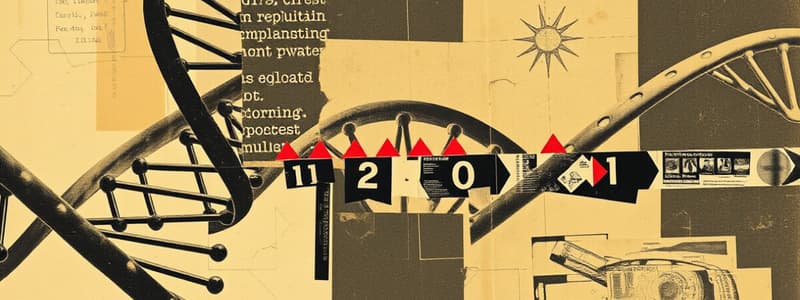Podcast
Questions and Answers
What is the importance of accuracy in DNA replication?
What is the importance of accuracy in DNA replication?
- Assuming a mutation rate of 1 error per million bases, there would be 6,400 mistakes each cell division (correct)
- There are millions of cell divisions over the course of human development (correct)
- A single-cell human zygote contains ~6.4 billion base pairs (correct)
- Must be fast (correct)
Which replication model suggests that the original double helix is copied into an entirely new double helix?
Which replication model suggests that the original double helix is copied into an entirely new double helix?
- Dispersive replication
- Semiconservative replication
- Conservative replication (correct)
What did Meselson and Stahl use to demonstrate semi-conservative DNA replication?
What did Meselson and Stahl use to demonstrate semi-conservative DNA replication?
- Equilibrium density gradient centrifugation (correct)
- PCR
- Gene cloning
- Centrifuge tube
What happens during equilibrium density gradient centrifugation?
What happens during equilibrium density gradient centrifugation?
After the first round of replication in the Meselson and Stahl experiment, which hypothesis could be eliminated?
After the first round of replication in the Meselson and Stahl experiment, which hypothesis could be eliminated?
If the dispersive model of DNA replication were correct, what would Meselson and Stahl have observed after the second round of replication in 14N?
If the dispersive model of DNA replication were correct, what would Meselson and Stahl have observed after the second round of replication in 14N?
What is a replicon?
What is a replicon?
What is theta replication?
What is theta replication?
What initiates rolling circle replication?
What initiates rolling circle replication?
What is the typical replication speed for linear eukaryotic DNA?
What is the typical replication speed for linear eukaryotic DNA?
Flashcards are hidden until you start studying
Study Notes
Importance of Accuracy in DNA Replication
- A human zygote has approximately 6.4 billion base pairs, necessitating high fidelity during replication.
- Millions of cell divisions occur throughout human development, presenting significant opportunities for errors.
- With a mutation rate of 1 error per million bases, roughly 6,400 mistakes could arise per cell division.
- Speed is essential; E. coli replicates its 4.6 million base pairs at approximately 1000 bases per second, completing division in around 20 minutes.
Models for DNA Replication
- Watson & Crick's double helix structure implies a template-based replication mechanism.
- Conservative replication: Entire original double helix is copied into a new double helix without mixing.
- Dispersive replication: New helices consist of hybrid DNA, mixing original and newly synthesized strands.
- Semiconservative replication: Each original strand serves as a template for creating a complementary strand.
DNA Replication is Semi-Conservative
- Meselson and Stahl's experiment in 1958 confirmed semi-conservative replication through density gradient centrifugation.
- Their method utilized heavy (15N) and light (14N) nitrogen isotopes to trace DNA incorporation during replication.
- Results indicated that DNA replication involves the separation of strands, with new strands being synthesized complementary to the templates.
Equilibrium Density Gradient Centrifugation
- Involves spinning a centrifuge tube filled with a heavy salt solution and DNA, creating a density gradient.
- Heavier DNA (with 15N) migrates to the bottom of the tube; lighter DNA (with 14N) remains closer to the top.
Meselson and Stahl's Experimental Design
- Bacteria were cultured in heavy 15N, followed by transfer to light 14N media for subsequent replications.
- After one round of replication, a single DNA band was observed, showing an intermediate density, eliminating the conservative model of DNA replication.
Implications of Dispersive Model
- If dispersive replication were correct, second round analysis would show only hybrid density DNA that is somewhat lighter than after the first round.
Mechanisms of DNA Replication
- Replication is driven by units called replicons, which include an origin of replication.
- Theta replication: Circular DNA unwinds at the origin, creating replication forks; if two forks move bidirectionally, an intermediate structure resembling theta forms.
- Rolling-circle replication: A break in one nucleotide strand initiates replication; the inner strand serves as the template while the outer strand is displaced, generating circular DNA molecules.
Linear Eukaryotic Replication
- Replication occurs at a pace of 500-5000 base pairs per minute from a single replication fork, significantly slower than prokaryotic replication.
- Eukaryotic chromosomes, often several hundred million bases long, require multiple origins of replication to ensure timely replication completion.
Studying That Suits You
Use AI to generate personalized quizzes and flashcards to suit your learning preferences.



